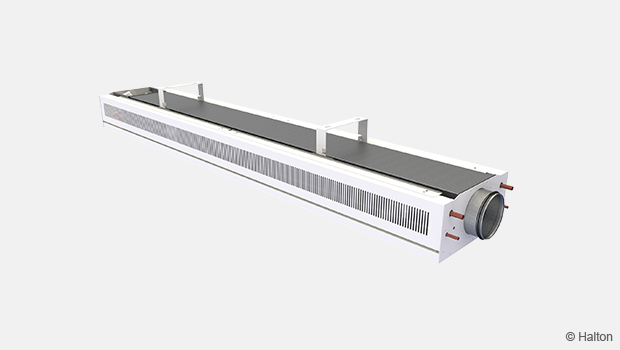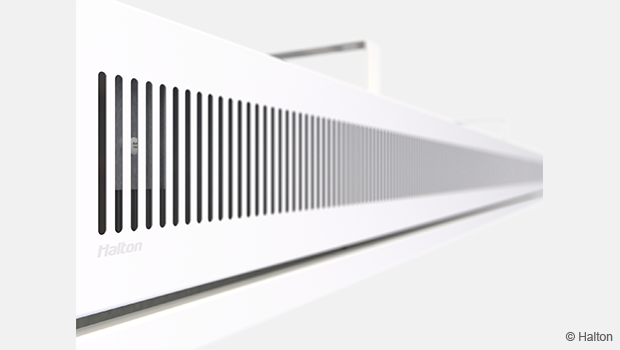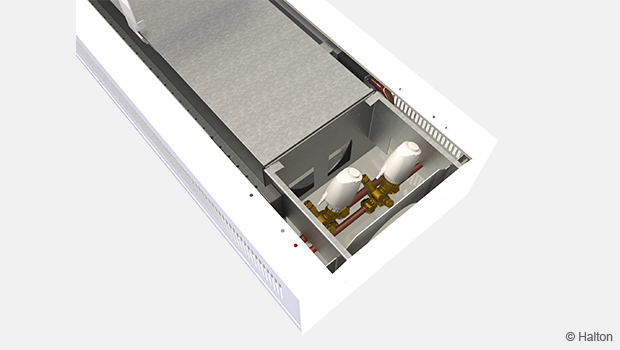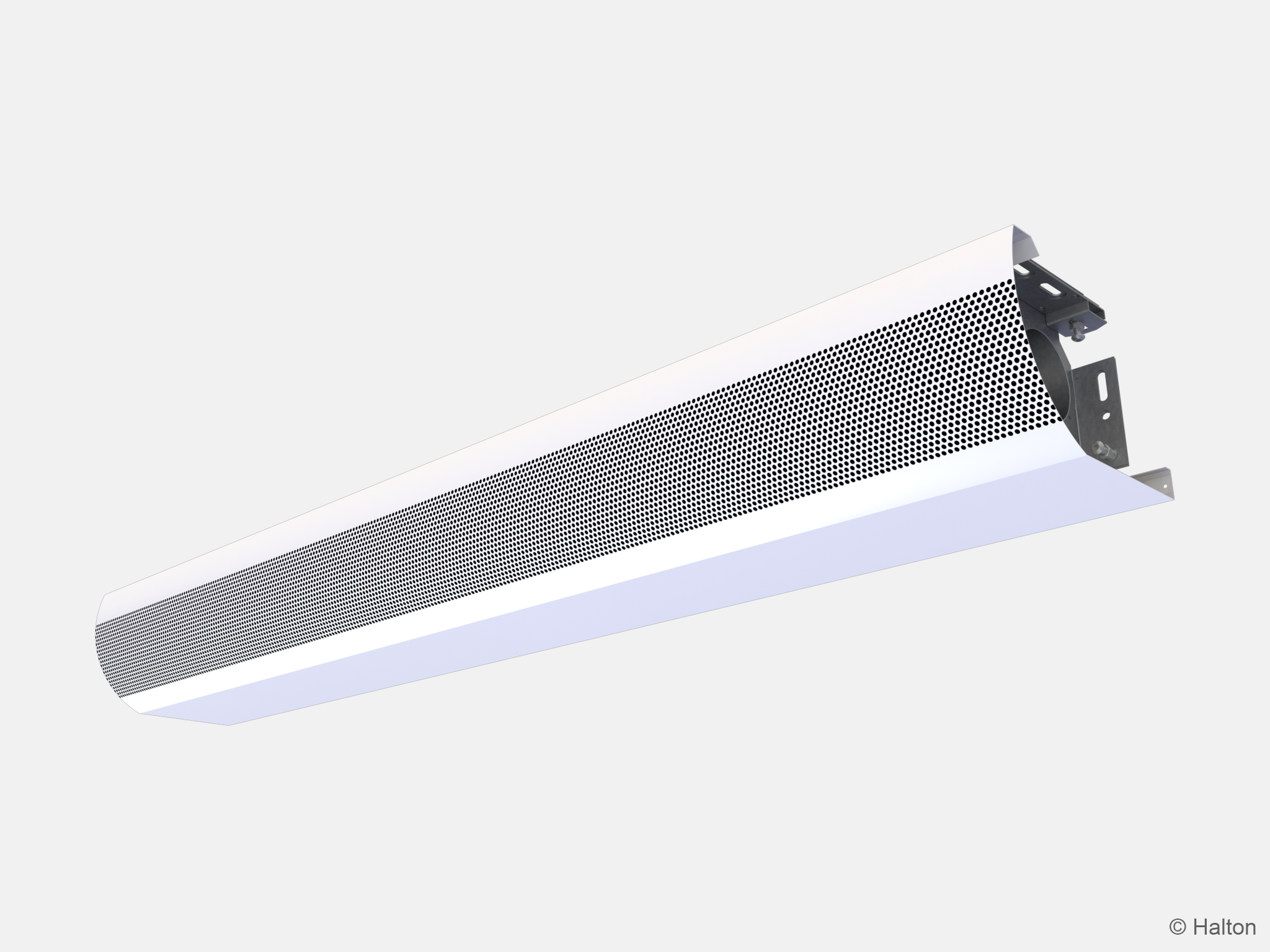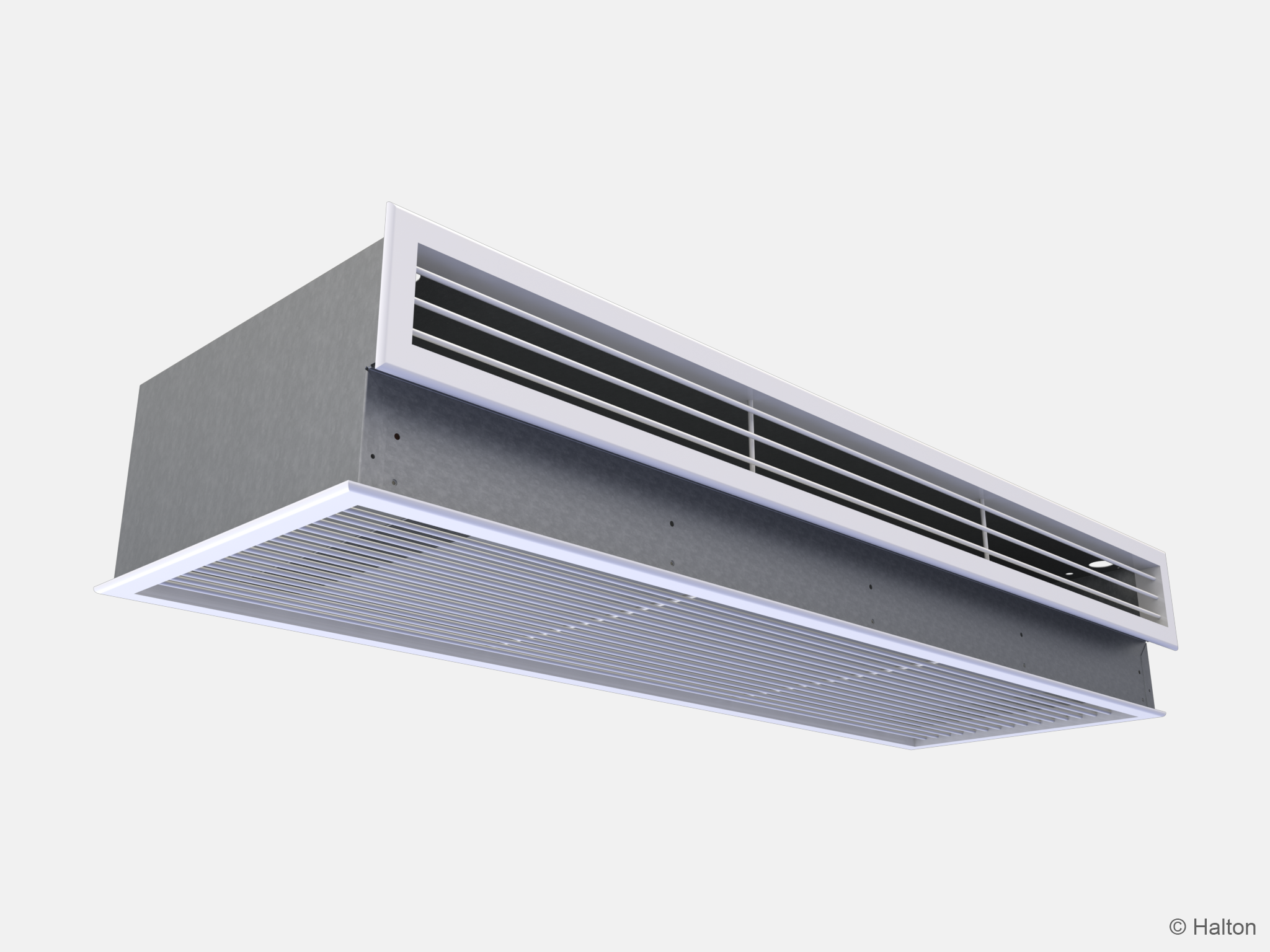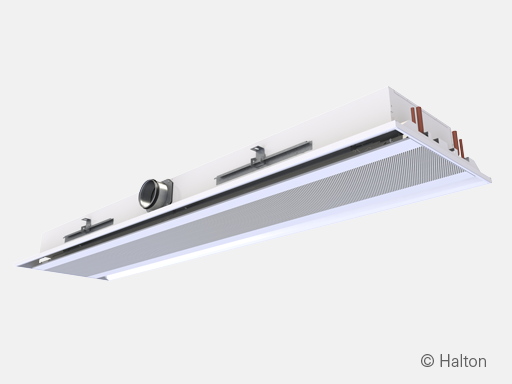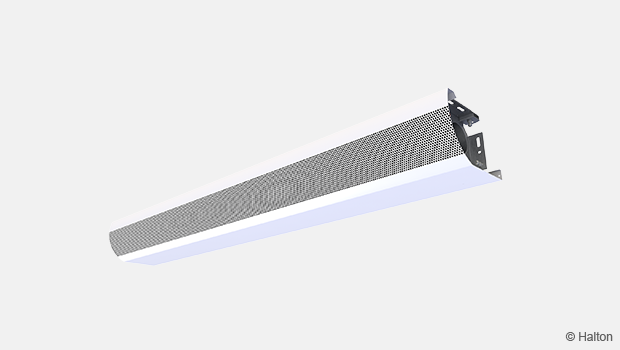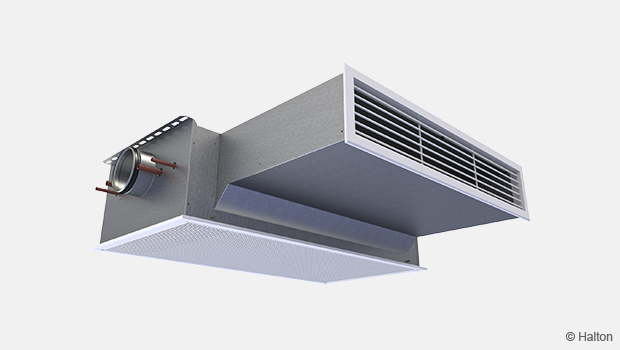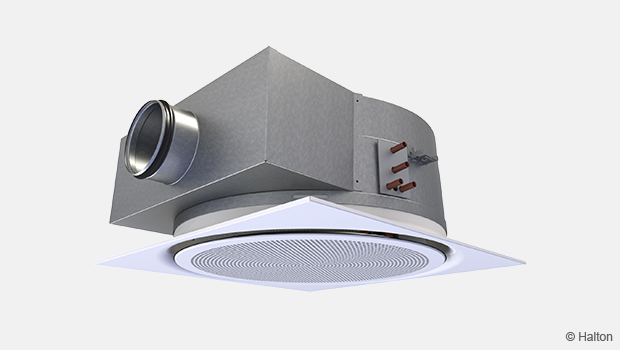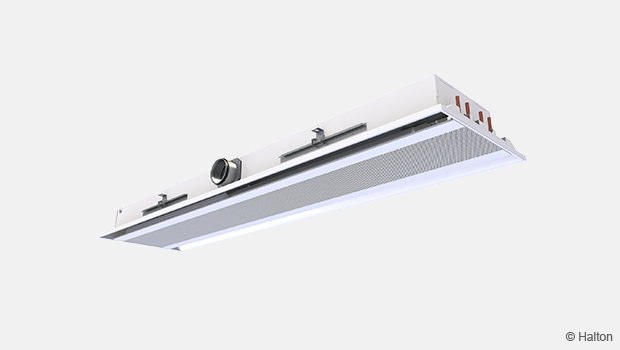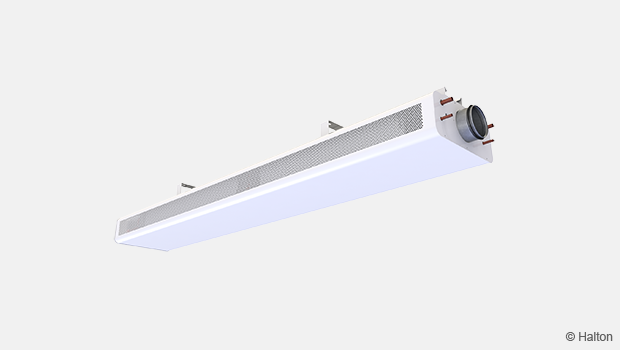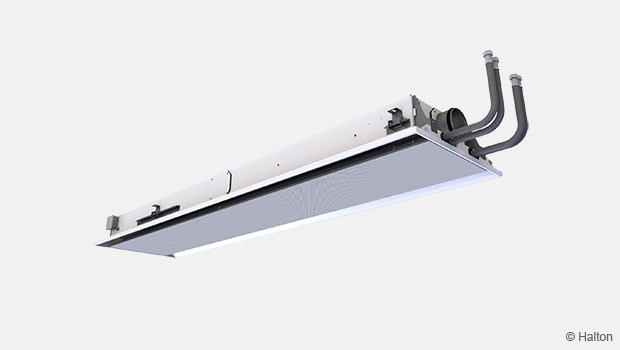Product / REO
Halton Rex REO – Variable air volume chilled beam (VAV)
Variable air volume chilled beam for Halton Workplace solution.
- Ideal for application where high quality indoor conditions, energy efficient operation and individual room control are appreciated
- Suitable for demand based Halton Workplace control system
- Enhanced life cycle performance with optimised air and water flow rates
Overview
Halton Rex REO chilled beam is:
- Suitable for demand based Halton Workplace control systems
- Combined cooling, heating, and supply air unit for exposed installation
- Well suited for demand based ventilation with constant static pressure ductwork
- Ideal solution for applications where high-quality indoor conditions, energy efficient operation and individual room control are appreciated
Typical applications: office rooms, landscape offices and meeting rooms.
Halton Rex REO chilled beam is designed for high quality office requirements with high flexibility of the airflow adjustability. The operation of this chilled beam will adapt to changes in the use of the space and office layout changes.
- Adjustable supply airflow rate changes with Operation Mode Damper (OMD).
- Individually adjustable velocity conditions with Halton Velocity Control (HVC).
- In-built flexibility for partition wall relocations with Halton Velocity Control.
- Demand based ventilation for efficient use of energy in constant-pressure ductwork zone applications.
- Enhanced life cycle performance with optimised air and water flow rates
Product models and accessories
- Model with combined cooling and heating coil
- Duct cover, integrated control valves and actuators as accessories
- Model with Halton Workplace WRA room automation system package
Halton chilled beams are certified by Eurovent Certita.

Dimensions
Connection types, air and water
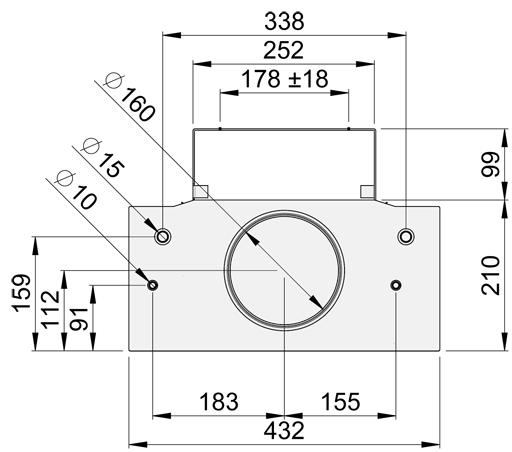
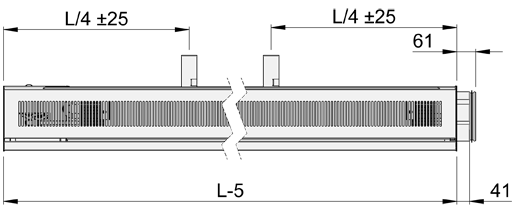
| Length, L [mm] | 1800, +100, …, 3600 |
| Coil length [mm] | 1500, +100, …, 3300 |
Valves
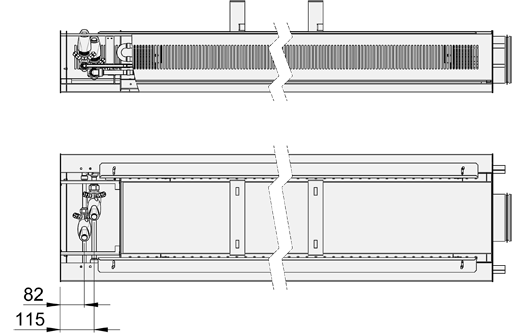
Material
| Part | Material | Finishing | Note |
| Front panel | Pre-painted galvanised steel |
Polyester-painted, white (RAL 9003 or RAL 9010, 20% gloss) |
Special colours available Polyester-epoxy-painted |
| Coil covers | Pre-painted galvanised steel |
Polyester-painted, white (RAL 9003 or RAL 9010, 20% gloss) |
Special colours available Polyester-epoxy-painted |
| End plates | Galvanised steel | Polyester-painted, white (RAL 9003 or RAL 9010, 20% gloss) |
Special colours available Polyester-epoxy-painted |
| Supply air plenum | Galvanised steel | – | – |
| Brackets | Galvanised steel | Polyester-epoxy-painted, white (RAL 9003) | Special colours available |
| Coil pipes | Copper | – | – |
| Coil fins | Aluminium | – | – |
Cooling/heating water pipe connections are Cu15/Cu10 with wall thickness of 0.9-1.0 mm fulfilling the requirements of European Standard EN 1057:1996.
The maximum operating pressure for chilled/hot water pipework is 1.0 MPa @ 70 °C.
Accessories
| Accessory | Code | Description | Note |
| Combined cooling and heating coil |
TC = H | Coil with hot water circulation | Cooling/heating. copper water pipe connections are Ø 15/10 mm |
| Cooling coil with air bleeder |
TC = CV | Coil with chilled water circulation | Cooling copper water pipe connection is Ø 15mm |
| Combined cooling and heating coil with air bleeders |
TC = HV | Coil with hot and chilled water circulation | Cooling/heating, copper water pipe connections are Ø 15/10 mm |
| Visual appearance | VA=See section Order code |
For appearance options see Fig. 1-6 | Selected options have the same performance data and dimensions. |
Visual appearance options (VA)
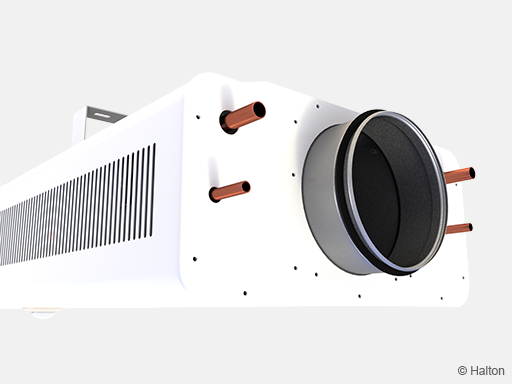
Fig.1. Rounded, oval perforation (RO)
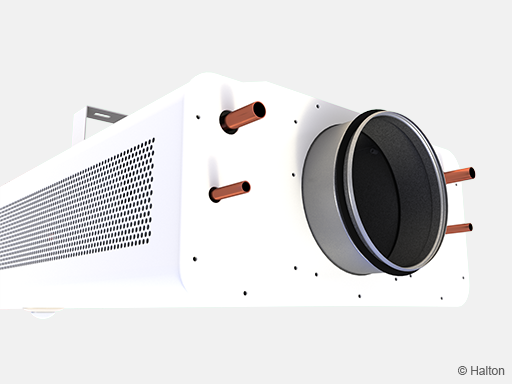
Fig.2. Rounded, round perforation (RR)
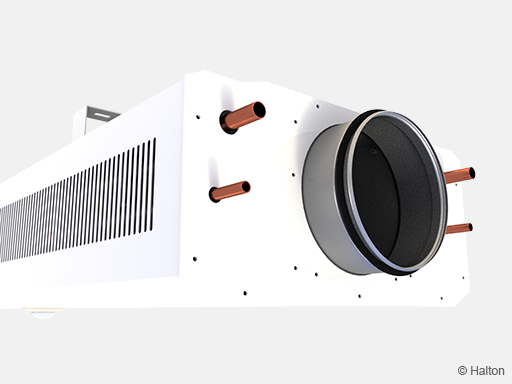
Fig.3. Angular, oval perforation (AO)
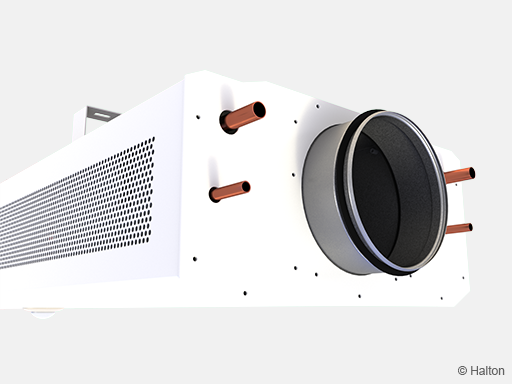
Fig.4. Angular, round perforation (AR)

Fig.5. Square with fixed front panel, oval perforation (SO)
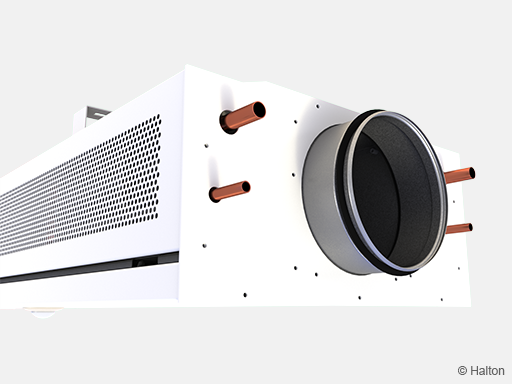
Fig.6. Square with fixed front panel, round perforation (SR)
Operating principle
The Halton Rex REO chilled beam is an active chilled beam for exposed installation.
The primary supply air enters the plenum of the active chilled beam, from which it is diffused into the room through nozzles controlled by Operation Mode Damper (OMD). The supply air nozzle jets efficiently induce ambient room air through the heat exchanger, where it is either cooled or heated. The supply air jet is directed horizontally along the ceiling surface. The recommended minimum distance is 600 mm from the wall and 100 mm from the ceiling.
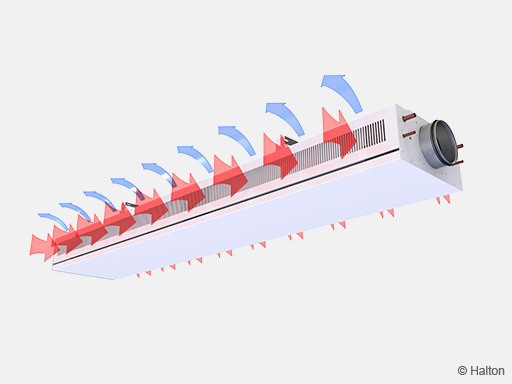
Fig.1. Function of the Halton Rex REO chilled beam
Velocity control in the occupied zone
Halton Velocity Control (HVC) is used for adjusting room air velocity conditions either when room layout is changed (e.g., in cases where the chilled beam is located near the partition wall) or when local, individual velocity conditions need to be altered. Halton velocity control adjustment has an impact on the induced room airflow through the heat exchanger, and therefore it either increases or decreases both the velocities in the occupied zone and the cooling/heating capacity of the chilled beam.
Halton Velocity Control involves manual velocity adjustment with three different positions (Fig.1. and 2.): 1 = Throttle, 2 = Normal, and 3 = Boost. The Halton velocity control system is divided into sections to enable the adjustment of conditions in different parts of the occupied zone. Depending on the length of the beam, optimal HVC damper module lengths between 500 and 1400 mm are used.
It is recommended to design the chilled beam in the normal position to allow both throttle and boost functions during the building s life cycle

Pos. 1 = Throttle position Pos. 2 = Normal position Pos. 3 = Boost position
Fig.2. Halton Velocity Control (HVC) from side
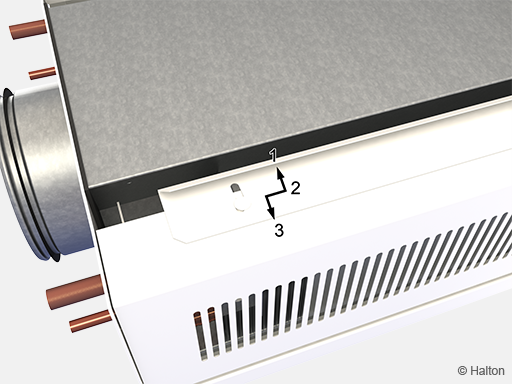
Pos. 1 = Throttle position / Pos. 2 = Normal position / Pos. 3 = Boost position
Fig.3. Halton Velocity Control (HVC) from top
Operation mode control
The supply airflow of the chilled beam nozzle jets is dependent on the nozzle type, nozzle row length and static chamber pressure.
The Operation Mode Damper (OMD, green in Fig. 4.) is used for adjusting and controlling the fresh airflow rate in a room space. The airflow rate is dependent on the opening position of the control damper. Operation mode of the room space is monitored with occupancy sensor.
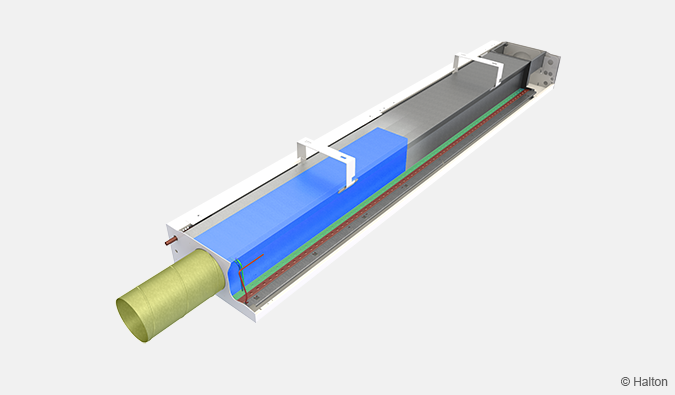
Fig.4. OMD (blue), Chamber 1 (green) , Chamber 2 (red)
Fig.5. presents the function in different modes controlled by the OMD. In unoccupied mode (1.) the supply airflow rate is set to minimum value that can remove material emission. In occupied mode (2.) supply airflow rate is set to normal office mode. When more persons are coming to the space, based on CO2-sensor airflow is increased to boost mode (3.) to maintain the set target value of the indoor air quality.

1. Unoccupied mode 2. Occupied mode 3. Boost mode
Fig.5. Supply air modes of the Halton Rex Exposed VAV beam
It is recommended that chilled beams for demand based airflows should be connected to constant pressure ductwork zone.
Temperature controls
The cooling and heating capacities of the chilled beam are controlled by regulating the water flow rate according to the control signal of the room temperature controller.
In heating mode, it is recommended that the temperature difference between the jet outlet and room air would not be greater than 3 °C. The inlet water temperature of the heat exchanger should not be higher than 35 °C. Optimal heating performance requires an appropriate primary airflow rate. Thus, the air handling unit shall be in operation during heating periods to ensure proper heating performance.
System package
Halton Workplace WRA room automation system package for Halton Rex REO chilled beam
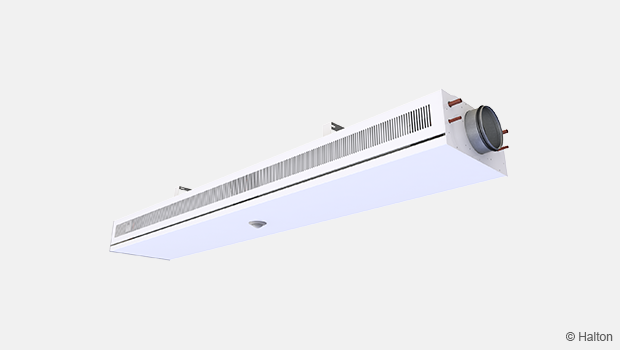
Fig. 1: Halton Workplace WRA room automation controller integrated to Halton Rex 600 (RE6) chilled beam
Halton Workplace WRA is a controller especially designed for controlling the automation system of office spaces and meeting rooms. It is used for controlling the ventilation airflow, room temperature, and indoor air quality.
The Halton Workplace WRA room automation package consists of a controller unit and optional components depending on customer needs: a wall panel and sensors for temperature, CO2, occupancy, pressure, and condensation.
There are options available for the controller unit and wall panel, depending on the number of controls and sensors required. The Halton Workplace WRA room automation controller is always combined with other Halton products for adaptable and high-level indoor climate.
Application area
- Controlling the ventilation airflow, room temperature, and indoor air quality in office spaces and meeting rooms
- The Halton Workplace WRA room automation controller is an important part of the Halton Workplace system, controlling room units and airflow control dampers
- Overall Halton Workplace System includes:
- Room air conditioning applications with Halton Workplace WRA room automation controller:
- Active chilled beams
- Exhaust units
- VAV dampers
- Active VAV diffusers
- Room air conditioning applications with Halton Workplace WRA room automation controller:
- Halton Max MDC zone control dampers
- Halton Workplace WSO system optimiser
Key features
- Factory-tested controller and wiring, easy to install
- Pre-installed project-specific parameters, quick to commission
- Several operating modes based on occupancy, thermal comfort, and indoor air quality
- Enables fully flexible layout solutions for changing needs in office environments
- Highly energy-efficient and reliable system operation
Operating principle
The Halton Workplace WRA room automation controller operates with Variable Air Volume (VAV) dampers and active chilled beams of the Halton Workplace system. These are used for adjusting the ventilation airflow, room temperature, and indoor air quality in office spaces.
Each room unit in an office space can have its own dedicated Halton Workplace WRA room automation controller, or a single controller can control multiple room units. The Halton Workplace WRA room automation controller can automatically adjust the system according to the indoor environment level preferred by users. Each room unit having its own dedicated controller brings maximum flexibility.
Room automation: Halton Rex REO active chilled beams controlled with Halton Workplace WRA room automation controllers
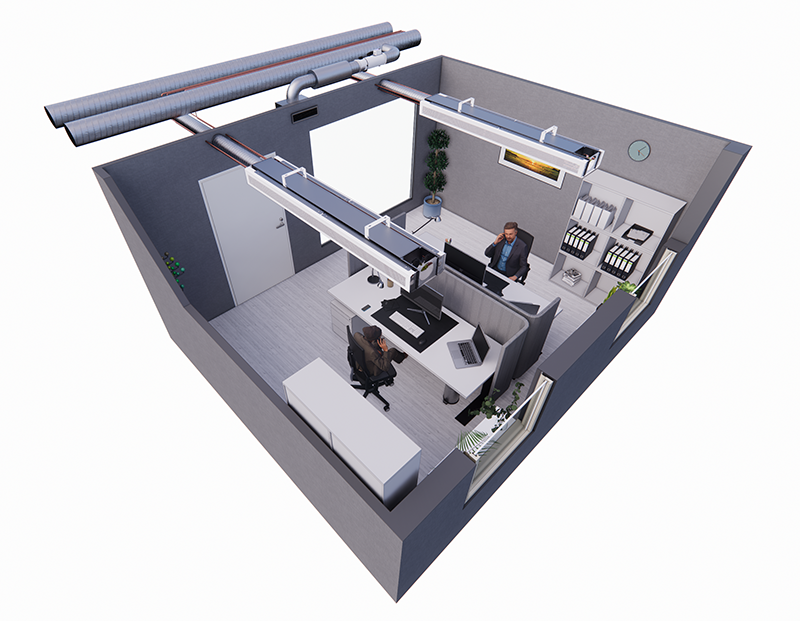
Fig. 2: Halton Rex Exposed VAV (REO) chilled beams controlled with Halton Workplace WRA room automation controllers in a double office room
Room automation description
In this configuration, two Halton Workplace WRA room automation controllers (DXR2.E12P-102A) control two Halton Rex REO active chilled beams. Each Halton Rex REO chilled beam has heating and cooling valves, a motorised Operation Mode Damper (OMD) control, and integrated CO2 and condensation sensors. A pressure sensor is integrated into the Halton Workplace WRA room automation controller. The system also includes an exhaust VAV damper and a wall panel (QMX3.P37) with temperature sensor and display. One Halton Workplace WRA room automation controller can individually control up to four terminal units, and there can be several Halton Workplace WRA room automation controllers in the room.
Design criteria for room automation
- Halton Rex REO chilled beam has heating and cooling valves
- Halton Rex REO chilled beam has motorised OMD control
- Condensation sensor and CO2 sensor integrated into REO chilled beam
- Exhaust airflow control
- Wall panel with temperature sensor and display
- Window switch control
- Pressure sensor integrated into Halton Workplace WRA room automation controller
Schematic drawing

Fig. 3: Schematic drawing: Halton Rex REO chilled beam (4-pipe) controlled with Halton Workplace WRA room automation controller
Equipment list
| Code | Equipment |
| RC | Controller unit |
| FG | Airflow damper actuator |
| FC | Airflow measurement |
| H | Water valve actuator |
| CS | Condensation sensor |
| OS | Occupancy sensor |
| PE | Pressure sensor |
| CO2 | CO2 sensor |
| WP | Wall panel |
| TE | Temperature sensor |
| TI | Temperature display |

Fig. 11: Factory-installed Halton Workplace WRA room automation controller DXR2.E12P-102A
Installation
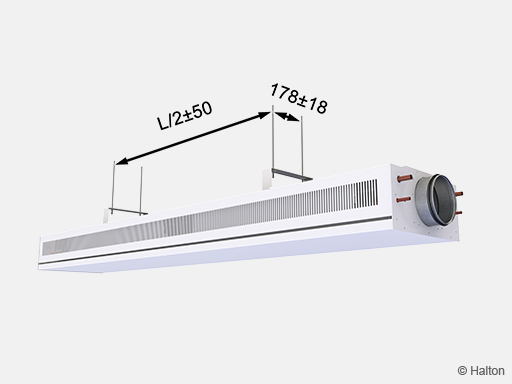
The Halton Rex Exposed VAV unit is suitable for exposed installation in the ceiling, typically lengthwise in the room. It is recommended to position the beam no closer than 600 mm from the wall and 100 mm from the ceiling. The chilled beam ceiling brackets can be fixed directly to the ceiling surface or suspended using threaded drop rods (8 mm). It is recommended that the brackets are positioned one quarter of a unit length (L/4) away from the end of the beam.
Install the main pipelines of the cooling and heating water loops above the level of the chilled beams to enable venting of the pipework.
Installation with brackets

Fig.1. Fixing of the beams done by pushing the beam to the ceiling brackets.
Secure all fixing points so that they are properly locked to the fixing slots.
Commissioning
Cooling
The recommended cooling water mass flow rate is 0.02 … 0.10 kg/s, resulting in a temperature rise of 1 … 4 °C in the heat exchanger. To avoid condensation, the recommended inlet water temperature of the heat exchanger is 14 … 16 °C.
Heating
The recommended heating water mass flow rate is 0.01 … 0.04 kg/s, resulting in a temperature drop of 5 … 15 °C in the heat exchanger. The maximum recommended temperature of the inlet water for the heat exchanger is 35 … 45 °C.
Balancing and control of water flow rates
Balance the water flow rates of the Halton Rex REO with adjustment valves installed on back end of the chilled beam. The cooling capacity and heating capacity of the chilled beam are controlled by regulating the water mass flow rate.
When setting the automatically balancing combination valve AB-QM, set the designed water flow rate in the valve body and verify the pressure difference (min. 7.5 kPa) between the measurement nipples of the valve. The pressure difference over the valve must be 16 kPa, to ensure proper operation.
The water mass flow rate can be controlled by using an ON/OFF valve or a two- or three-way proportional valve.
Adjustment of supply airflow rate
Connect a manometer in the measurement tap and measure the static pressure in the Halton Rex REO chilled beam. The measurement tab locations for OMD and chambers 1 and 2 are presented in Fig.1.
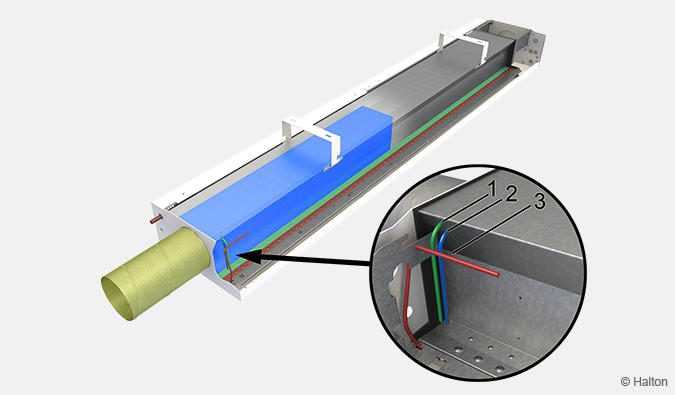
Fig.1. Location of measurement tabs
Key:
1. Chamber 1 (green)
2. OMD (blue)
3. Chamber 2 (red)
The airflow rate is calculated according to the formula below:
Total airflow rate (qv)

qv Total airflow rate, l/s or m3/h
qv1 Chamber 1 nozzle jet airflow rate, l/s or m3/h
qv2 Chamber 2 nozzle jet airflow rate, l/s or m3/h
Nozzle jet airflow rate for Chamber 1 and 2 (qv1 and qv2)

l eff Length of the coil [m)
Δpm Measured static chamber pressure [Pa]
| Nozzle | k [l/s] | k [m3/h] |
| A | 0.71 | 2.56 |
| B | 1,01 | 3,64 |
| C | 1,41 | 5,08 |
| D | 2.08 | 7,49 |
Same k factors will be used to all the operation modes.
Please note the leff may differ between the normal and boost modes.
Servicing
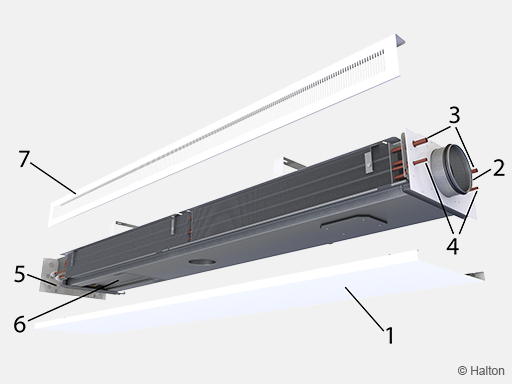
Key:
1. Front panel
2. Supply air connection
3. Chilled water pipe connection
4. Heating water pipe connection
5. Control valves and actuators
6. Controller
7. Coil cover
Remove the coil covers and front panel of the Halton Rex REO. Clean the supply air plenum, duct and finned coils of the heat exchanger using a vacuum cleaner, taking care not to damage the finned coils. Clean the front panel and, if necessary, the side plates with a damp cloth.
Specification
The unit is an active chilled beam for exposed installation with bi-directional air supply.
The front panel is openable and detachable from either side to allow maintenance and cleaning.
The chilled beam is 432 mm wide and 210 mm high, with inlet duct diameter of 160 mm.
The chilled beam can be equipped with a duct cover to cover the connection duct and pipe installations (optional).
The front panel and side panels are made of pre-painted galvanised steel plate (white, RAL 9003).
All visible parts can be painted with special colours (RAL xxxx).
The primary airflow rate is adjustable from minimum to maximum (0-100%)
when static chamber pressure is kept constant.
The chilled beam unit is equipped with a motorised Operation Mode Damper (OMD).
The induced room airflow rate is manually adjustable to three positions without influencing the primary air supply flow rate.
All pipes are manufactured from copper, connection pipes with a wall thickness of 0.9-1.0 mm.
The fins of the heat exchanger are manufactured from aluminium.
Heating is incorporated within the heat exchanger via two 10 mm pipes connected in series. All joints are factory pressure-tested.
The maximum operating pressure of the pipework is 1.0 MPa @ 70 °C.
Each chilled beam is protected by removable plastic coating.
Duct connection and pipe ends are sealed for transit.
Each chilled beam is identifiable by a serial number printed on a label attached to the chilled beam.
Order code
REO/S-L-P-D, TC-VA-CO-ZT
S = Nozzle type (1st row)
A Extra small
B Small
C Medium
D Large
L = Beam length [mm]
1800, +100,..,3600
P = Nozzle type (2nd row)
A Extra small
B Small
C Medium
D Large
D = Nozzle length (2nd row)
1200, +100,..,3300
Other options and accessories
SP = System package
N No
Y Yes
TC = Cooling / Heating functions (coil type)
C Cooling
H Cooling and Heating
CV Cooling, with venting valves
HV Cooling and heating, with venting valves
VA = Visual appearance
RO Rounded, oval perforation
RR Rounded, round perforation
AO Angular, oval perforation
AR Angular, round perforation
SO Square with fixed front panel, oval perforation
SR Square with fixed front panel, round perforation
CO = Colour
SW Signal white (RAL 9003)
W Pure white (RAL 9010)
X Special colour (RAL xxxx)
ZT = Tailored product
N No
Y Yes (ETO)
Sub products
System package Halton Workplace Room Automation WRA
Room exhaust VAV damper Halton Max MOC
Room exhaust VAV damper Halton Max MUC
Order code example
REO-A-3000-B-2700, SP=N, TC=C, VA=SO, CO=SW, ZT=N
Downloads
"*" indicates required fields

